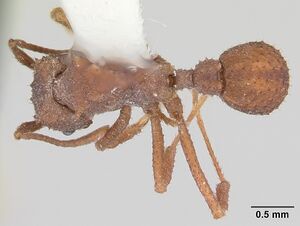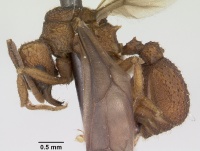Trachymyrmex carinatus
| Trachymyrmex carinatus | |
|---|---|

| |
| Scientific classification | |
| Kingdom: | Animalia |
| Phylum: | Arthropoda |
| Class: | Insecta |
| Order: | Hymenoptera |
| Family: | Formicidae |
| Subfamily: | Myrmicinae |
| Tribe: | Attini |
| Genus: | Trachymyrmex |
| Species: | T. carinatus |
| Binomial name | |
| Trachymyrmex carinatus Mackay, W.P. & Mackay, E.E., 1997 | |
A ground nesting species that can be found in open exposed areas with sparse ground cover or in oak-juniper-pinyon woodlands.
Identification
In southern Arizona, T. carinatus co-occurs with Trachymyrmex arizonensis in mid elevation habitats. Workers and queens of these two species are easily distinguished by the distinctive frontal lobes of T. arizonensis and the preocular carinae nearly touching the frontal carinae in T. carinatus (not closely approaching the frontal carinae in T. arizonensis). T. carinatus also sometimes co-occurs with Trachymyrmex pomonae from which it may be separated by its larger size and symmetrical frontal lobes (lobes notably asymmetric in T. pomonae). In addition, workers of T. carinatus are superficially very similar to those of the allopatric Trachymyrmex septentrionalis, from which they may be separated by the characters given in the key. (Rabeling et al. 2007).
Keys including this Species
Distribution
Trachymyrmex carinatus was described by Mackay & Mackay (1997), based on specimens collected in Chihuahua, Mexico, and the Chiricahua Mountains of southeastern Arizona. T. carinatus occurs in central and southern Arizona, western New Mexico and the Mexican States of Sonora, Chihuahua and Coahuila, often in sympatry with Trachymyrmex arizonensis. A single collection from the Kofa Mountains in southwest Arizona marks its westernmost limit. (Rabeling et al. 2007).
Latitudinal Distribution Pattern
Latitudinal Range: 33.78166667° to 17.830278°.
| North Temperate |
North Subtropical |
Tropical | South Subtropical |
South Temperate |
- Source: AntMaps
Distribution based on Regional Taxon Lists
Nearctic Region: United States.
Neotropical Region: Mexico (type locality).
Distribution based on AntMaps
Distribution based on AntWeb specimens
Check data from AntWeb
Countries Occupied
| Number of countries occupied by this species based on AntWiki Regional Taxon Lists. In general, fewer countries occupied indicates a narrower range, while more countries indicates a more widespread species. |

|
Estimated Abundance
| Relative abundance based on number of AntMaps records per species (this species within the purple bar). Fewer records (to the left) indicates a less abundant/encountered species while more records (to the right) indicates more abundant/encountered species. |

|
Habitat
T. carinatus has been encountered most commonly in the mountains of southern and central Arizona in mid elevation habitats (800–1800m). Colonies may be found in open exposed areas with sparse ground cover, such as washes or roadsides, but are especially abundant in oak-juniper-pinyon woodlands. (Rabeling et al. 2007).
Biology
|
From Rabeling et al. (2007): Specimens from the Kofa Mountains were collected from a nest next to a water seep shaded by palm trees on the wall of a canyon at ~800 m elevation (R. Snelling, personal communication). Nests are sometimes found under stones, but are more often encountered in open ground, where they can be recognized by the circular shape of the nest crater, which contrasts with the more amorphous nest excavations of T. arizonensis. Excavations by C. Rabeling reveal that nests in the Chiricahua Mountains of southern Arizona have one to three fungus garden chambers, with the shallowest chamber only 5 cm beneath the soil surface. Colonies have fewer than 100 workers. Mating flights occur near dawn on mornings following summer rains. (Mackay & Mackay 1997).
Castes
Images from AntWeb
   
| |
| Paratype of Trachymyrmex carinatus. Worker. Specimen code casent0103159. Photographer April Nobile, uploaded by California Academy of Sciences. | Owned by USNM, Washington, DC, USA. |
Nomenclature
The following information is derived from Barry Bolton's Online Catalogue of the Ants of the World.
- carinatus. Trachymyrmex carinatus Mackay & Mackay, 1997a: 44, figs. 1, 2 (w.q.m.) MEXICO (Chihuahua).
- Type-material: holotype worker, 29 paratype workers, 15 paratype queens, 3 paratype males.
- Type-locality: holotype Mexico: Chihuahua, Municipio Riva Palacio, 15 km. W Bellavista, 16.viii.1981 (E. Mackay); paratypes with same data.
- Type-depositories: MCZC (holotype); AMNH, LACM, LESM, MCZC, MZSP, USNM, WEMC (paratypes).
- Combination in Trachymyrmex: Solomon, Rabeling, et al. 2019: 948
- Status as species: Rabeling, et al. 2007: 8 (redescription).
- Distribution: Mexico, U.S.A.
Type Material
- Holotype, worker, 15km W Bellavista, Municipio Riva Palacio, Chihuahua, Mexico, Museum of Comparative Zoology; see Rabeling et al. (2007).
- Paratype workers, paratype queens, and males American Museum of Natural History, William and Emma Mackay Collection, Los Angeles County Museum of Natural History, Museum of Comparative Zoology, National Museum of Natural History. Examined (Rabeling et al. 2007).
Unless otherwise noted the text for the remainder of this section is reported from the publication that includes the original description.
Description
Worker
Diagnosis from Rabeling et al. (2007): HL 0.8–1.0, HW 0.8–1.04, CI 96–108, SL 0.84–1.04, SI 100–105, ML 1.2–1.44. A relatively small species (HL 0.8–1, HW 0.8–1.04) with normally proportioned legs and antennal scapes (SI 100–105). Head more or less square (CI 96–108), sides subparallel posterior to the eyes, slightly tapering anteriorly between the eyes and mandibular insertions. Posterior margin weakly to moderately concave. Preocular carinae long, strongly curving mesially, and traversing nearly the entire distance between the eye and the frontal carinae, sometimes nearly touching the frontal carinae or appearing to do so. In full-face view, frontal lobes more or less symmetrical. Anterolateral promesonotal teeth moderate in size, pointed in dorsal view, projecting horizontally, not vertically. Anterior median pronotal tubercles small or reduced to denticles, or if tooth-like short and broadly pyramidal. Propodeal teeth usually acute, about as long as the distance between their bases. Dorsal surface of body moderately tuberculate, tuberculi generally moderate in size, bearing recurved setae. First gastric tergite coarsely and conspicuously tuberculate. Color brownish to yellow to medium reddish-brown.
Queen
Diagnosis from Rabeling et al. (2007): HL 1.1–1.25, HW 1.15–1.4, CI 105–112, SL 1.1–1.15, SI 82–96, ML 1.9–2.1. As in worker diagnosis, except for typical caste-specific morphology of the mesosoma related to wing-bearing and head with minute ocelli. Dorsolateral pronotal teeth well-developed, tuberculate, sharply triangulate in dorsal view, often blunt-tipped in anterior view. Mesoscutum coarsely and irregularly rugulose, sometimes with faint longitudinal pattern, minutely tuberculate, and with abundant short, suberect, slightly recurved setae.
Male
Diagnosis from Rabeling et al. (2007): HL 0.72–0.81, HW 0.75–0.84, CI 104, SL 0.81–0.9, SI 104–111, ML 1.6–1.8. Somewhat variable in size, but presenting the following characters: Dorsolateral pronotal tooth absent in dorsal view, ventrolateral pronotal tooth small, broadly to narrowly triangular. Mesoscutum irregularly rugulose, interrugal spaces coarsely granulose. Preocular carina a prominent vertical ridge, remaining strongly developed at least until it reaches the midpoint of the posterior border of the antennal scrobe. In full-face view, posterior corners of head more or less rounded, their outlines obscured by the presence of several conspicuous toothlike tuberculi on each corner.
Etymology
The species name “carinatus” refers to the well-developed carinae on the vertex of the workers’ and queens’ heads. (Rabeling et al. 2007).
References
- Alatorre-Bracamontes, C.E., Vásquez-Bolaños, M. 2010. Lista comentada de las hormigas (Hymenoptera: Formicidae) del norte de México. Dugesiana 17(1): 9-36.
- MacKay, W. P.; MacKay, E. E. 1997a. Una nueva especie de hormiga del género Trachymyrmex (Hymenoptera: Formicidae) del Estado de Chihuahua, México. Sociobiology 30: 43-49 (page 44, figs. 1, 2 worker, queen, male described)
- Prebus, M.M. 2021. Taxonomic revision of the Temnothorax salvini clade (Hymenoptera: Formicidae), with a key to the clades of New World Temnothorax. PeerJ 9, e11514 (doi:10.7717/peerj.11514).
- Rabeling C, Cover SP, Mueller UG and Johnson RA. 2007. A review of the North American species of the fungus-gardening ant genus Trachymyrmex (Hymenoptera: Formicidae). Zootaxa. 1664:1-54.
- Solomon, S.E., Rabeling, C., Sosa-Calvo, J., Lopes, C.T., Rodrigues, A., Vasconcelos, H.L., Bacci Jr, M., Mueller, U.G., Schultz, T.R. 2019. The molecular phylogenetics of Trachymyrmex Forel ants and their fungal cultivars provide insights into the origin and coevolutionary history of ‘higher-attine’ ant agriculture. Systematic Entomology 44: 939-956 (doi:10.1111/syen.12370).
References based on Global Ant Biodiversity Informatics
- Dattilo W. et al. 2019. MEXICO ANTS: incidence and abundance along the Nearctic-Neotropical interface. Ecology https://doi.org/10.1002/ecy.2944
- Franklin K. 2012. The remarkable resilience of ant assemblages following major vegetation change in an arid ecosystem. Biological Conservation 148(1): 96-105.
- Johnson R. Personnal Database. Accessed on February 5th 2014 at http://www.asu.edu/clas/sirgtools/resources.htm
- Rabeling C., S. P. Cover, R. A. Johnson, and U. G. Mueller. 2007. A review of the North American species of the fungus-gardening ant genus Trachymyrmex (Hymenoptera: Formicidae). Zootaxa 1664: 1-53
- Solomon S. E., C. Rabeling, J. Sosa-Calvo, C. Lopes, A. Rodrigues, H. L. Vasconcelos, M. Bacci, U. G. Mueller, and T. R. Schultz. 2019. The molecular phylogenetics of Trachymyrmex Forel ants and their fungal cultivars provide insights into the origin and coevolutionary history of ‘higher-attine’ ant agriculture. Systematic Entomology 44: 939–956.
- Vásquez-Bolaños M. 2011. Lista de especies de hormigas (Hymenoptera: Formicidae) para México. Dugesiana 18: 95-133

